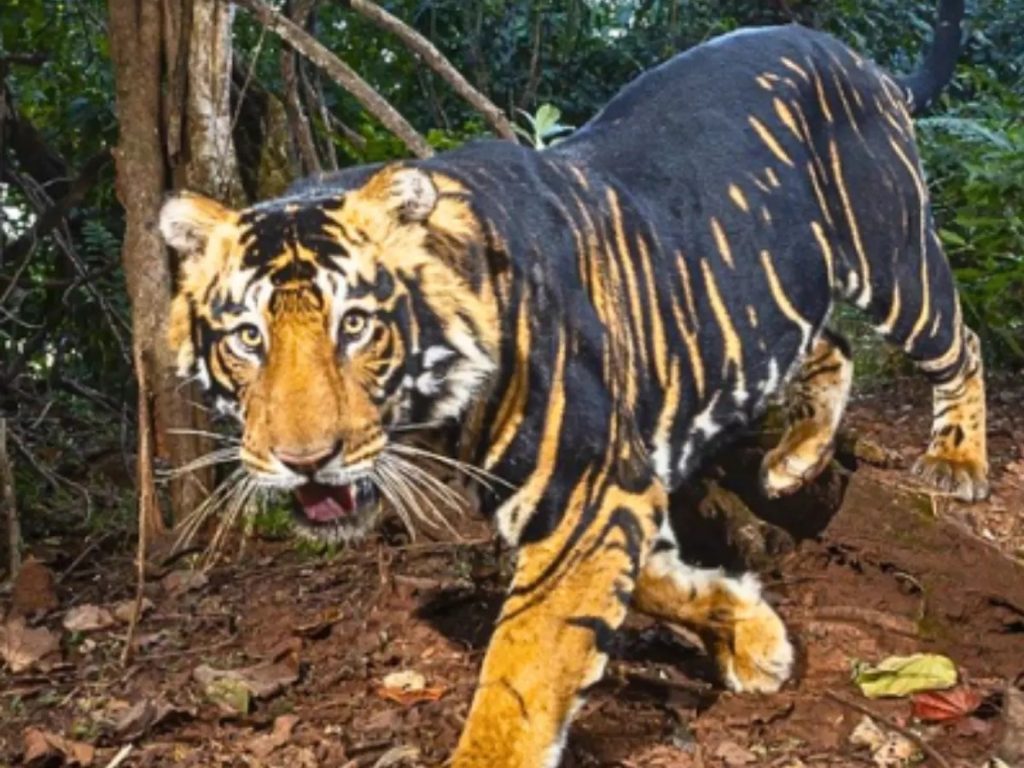
Cats are one of the families of species that perhaps show rare colourations relatively regularly. I say relatively, because naturally these can be very rare. Like a black leopard or a king cheetah, these can exist as a recessive gene.
Having said this, a tiger with more black on it, may well be better at hunting when there is little light, which could boost its chances of breeding effectively. This picture is from late in 2023, from Similipal Tiger Reserve in Odisha. There is a significant history of this genetic mutation in this reserve (though that is not particularly surprising, as black leopards and similar are also genetic so tend to occur in the same area for a time).
Back in 1976 2 black tigers (adults) were seen on the road towards Matughar meadow, In 1990, it was scientifically confirmed, and in 1993, a female black tiger was shot by a boy in self defence, on the outskirts of a village not far from the reserve.
In 2021, a paper traced the mutation that causes the black tigers’ unique coat pattern to a single gene called Transmembrane Aminopeptidase Q (Taqpep). These sorts of animals are relatively more common in small populations than big ones – with the total population being only 35 as of last year.
These rare colourings are also far more common in captivity. This is (as likely with the wild population) not for healthy reasons.
In captivity, when a white tiger or black leopard is either born, or is captured from the wild, it is often bred with closely related family members, in order to retain the genetic mutation (the white tigress started a line of white tigers – of which there are now roughly 200 around the world. This white tiger population is all related, and was started from a male “mohon” captured in India in the 1950s. He was bred with one of his daughters. It is true that with careful management of the captive population, one would hope to breed out bad genetic abnormalities, but often zoos were more worried about having an interesting specimen than worrying about genetics. This has improved dramatically in recent years, but has meant that many zoos have hybrids of various subspecies (such as a hybrid tiger that is half bengal and half amur) – while these hybrids might have interest, one of the primary reasons that are often given for zoo animals, is as a buffer in case the wild animal becomes extinct. A hybrid animal, is unlikely to have the physical attributes to either survive in the extreme heat of the Indian plains, or the snowy mountains of the Amur region.
It should be noted, that while these animals have a specific fascination for humanity, there are rarely enough to create a population of these rare coloured animals. Furthermore, given the threat that tigers still face (it is quite true that that tigers have recovered over the last decade, to the point where there are over 3682, up from less than half of that number in 2006 (when the population was roughly 1400).
To put these numbers in perspective, when the British arrived in 1860, there were thought to be around 100,000, but around 65,000 were hunted in the time till 1950, when there was an estimated 40,000. It is true, that many reserves have space for plenty more tigers (some, when surveys were done by pugmarks alone, had claims of 40 in the population, actually had no tigers left), and it seems reasonable to suppose, that a further doubling of the tiger population might be possible if every reserve was full, many of the well protected reserves are at capacity. Thus, future improvements might require more than an end of poaching, but also improving the prey base in reserves that have been over poached.
Sahyadri, Satkosia, Kawal and Kamlang tiger reserves were all found to have no tigers in 2022, while Indravati tiger reserve was found to only have one tiger left (and when there is only one tiger, we can be sure that there will be no offspring, unless another in translocated into the area – meaning the tiger will be extinct here as well in the near future).
Black tigers are fascinating, and clearly the genetic mutation does give some advantage. Never-the-less, while everything should be done to save the tigers of the Similipal Tiger Reserve, while this may mean that the black tiger continues to survive and thrive. The reserve has suffered significant ungulate poaching, which leads to concerns that the small tiger population might not survive long-term anyway, as well as direct issues with people invading the reserve.
Should this reserve reach, and exceed carrying capacity, then it might well be useful to translocate some of the tigers elsewhere, and the tigers translocated might well carry the black tiger gene, but this cannot be the primary aim.











